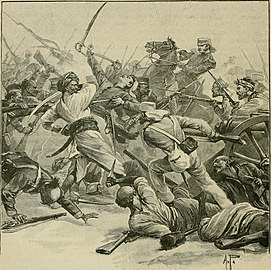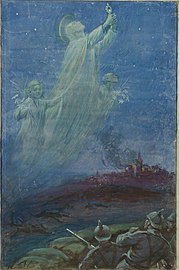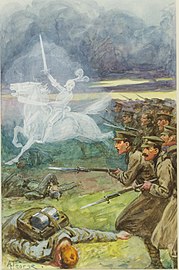Alfred Pearse
Alfred Pearse | |
|---|---|
 | |
| Born | Alfred Pearse 20 May 1855 St Pancras, London, England |
| Died | 1933 (aged 77–78) London, England |
| Nationality | British |
| Education | West London School of Art |
| Known for | Painting and illustration |
| Notable work |
|
| Spouse | Mary Blanche Lockwood |
| Children | 6 |
Alfred Pearse (20 May 1855 – 1933), also known as A Patriot, was an English artist, author, campaigner and inventor. Pearse, born at St Pancras, London, was a fourth generation artist and son of celebrated decorative artist Joseph Salter Pearse (1822–1896)[2][3] and Loveday Colbron (1825–1895).[4] He studied at West London School of Art and gained numerous prizes for drawing.[5]
As special artist and correspondent to The Sphere, he was assigned to the Duke and Duchess of Cornwall and York's 1901 tour of New Zealand.
Pearse designed posters campaigning for women's suffrage. He drew a weekly cartoon for Votes for Women from 1909, and was also regularly published in The Illustrated London News, Boy's Own Paper and Punch. With Laurence Housman, he set up the Suffrage Atelier.[6]
Pearse produced various artworks, cartoons and propaganda related to British efforts in World War I. From 11 September 1918 to March 1919, he held an honorary captain's commission in the New Zealand Rifle Brigade, NZEF, as official artist, painting the battle scenes in which the 1st NZRB figured.[7][1][8] He was attached to Brigadier General Charles Melvill's headquarters and left London for France on 27 September 1918.
He was a wood engraver, book illustrator and art critic, including for the Manchester Guardian, and for eight years had been a member of Joseph Barnby's Royal Choral Society.[5]
Amongst his inventions, he'd patented improvements to vehicle and cycle wheels,[9] improvements relating to the frames of velocipedes,[10] a method for animating advertising hoardings in 1908–1912,[11][1] improvements in flying machines,[12] devised a model air-ship for the October 1905 readers of The Boy's Own Paper[13] and a method of preserving shores.[1]
His son Denis Colbron Pearse (1883–1971) also was an illustrator.
Gallery
-
The Highland Clans, The Boy's Own Paper, 1883
-
Illustration from The Adventures of Louis de Rougemont, 1899
-
Fight at Paparatu in 1865 during Te Kooti's War, 1901
-
It was Bayonet to Bayonet, 1901. The Siege of Delhi in 1857
-
Women's Social & Political Union poster, 1910
Artist: A Patriot -
Spirit of War, 1914
-
The Angel of Mons, 1915
-
Saint George, 1915
References
- ^ a b c d Notable Londoners: An Illustrated Who's Who of Professional and Business Men. London: London Publishing Agency. 1921–1922. p. 183.
- ^ "Alfred Pearse: Artist". Look and Learn. 12 July 2011. Retrieved 9 April 2022.
- ^ Pearse, Joseph Salter (1854). "Design for Decorative Panels with Hunting Scenes Inset" – via The Met, New York.
- ^ "England Biths and Christenings, 1538–1975", FamilySearch
- ^ a b "Artists of "The Strand Magazine"" (PDF). The Strand Magazine. Vol. 10. July–December 1895. p. 790.
- ^ Atkinson, Diane (1997). Funny Girls: Cartooning for Equality. Penguin Books. p. 44. ISBN 9780140266993.
- ^ Schofield, Guy H., ed. (11 October 1918). "On Service" (PDF). The New Zealander: Home News for New Zealanders on Active Service. No. 49. London. p. 3.
- ^ "Alfred Pearse". Online Cenotaph. Auckland War Memorial Museum. Retrieved 7 April 2022.
- ^ GB Patent 26,186, Alfred Pearse, "Improvements relating to Wheels for Cycles and Vehicles", published 1897-10-23, issued 1897-10-23
- ^ GB Patent 26,664, Alfred Pearse, "Improvements Relating to the Frames of Velocipedes", published 1897-10-23, issued 1897-10-23
- ^ GB Patent 22,378, Alfred Pearse & Frederick James Oldacres, "Improvements Relating to Advertising Devices", published 1909-12-21, issued 1909-12-21
- ^ GB Patent 29,027, Alfred Pearse, "Improvements in Flying Machines", published 1914-09-17, issued 1914-09-17
- ^ "The B.O.P. Airship and How to Make it Sail". The Boy's Own Paper. Vol. 28, no. 1395. 7 October 1905. pp. 9–11.
External links
- Works by Alfred Pearse at Project Gutenberg
- Works by or about Alfred Pearse at the Internet Archive
- Alfred Pearse at Library of Congress, with 5 library catalogue records








